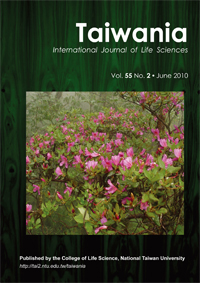Research Paper
Competitive Exclusion of Parthenium hysterophorus by Other Invasive Species - A Case Study from Andhra Pradesh, India
J. Asha kumari, P. Rama Chandra Prasad and K. B. Reddy
Published on: 15 June 2010
Page: 128 - 138
DOI: 10.6165/tai.2010.55(2).128
Abstract
The abundance, dominance and growth performance of Parthenium hysterophorus in relation to its field associates in extensively large areas was investigated. The preliminary analysis of the data revealed that P. hysterophorus is a weak or poor competitor and hence it fails to grow in the company of any aggressive species. Senna uniflora and a few other plants were identified for the control of this pernicious weed. The ability of other species to control P. hysterophorus was attributed to allelopathy. In order to understand how Hyptis suaveolens and Senna uniflora are capable of arresting the growth of P. hysterophorus, pot culture experiments in de Wit replacement series, field experiments in experimental plots and experimental manipulation of the competitive species under natural conditions during different seasons were carried out for two years in 2004 and 2005. The results clearly revealed that both H. suaveolens and S. uniflora were highly effective in the management of P. hysterophorus. The results further showed that the physical dominance and the ability of the competitive species to deprive P. hysterophorus of light are mainly responsible for the decline of P. hysterophorus. Allelopathy doesn't seem to play any effective role under natural conditions.
中文摘要
我們在大面積的野外環境中,調查了銀膠菊 (Parthenium hysterophorus) 以及其所伴生的物種在野外的豐富度、優勢度以及生長情形。初步的分析顯示銀膠菊屬於弱勢的競爭者,無法與競爭力強的其他入侵植物共存,因此,單花決明 (Senna unifora) 以及其它幾個較為強勢的物種,被認為是可能控制銀膠菊的工具。為了瞭解優勢的入侵物種單花決明以及香苦草 (Hyptis suaveolens) 如何與具有毒他作用的銀膠菊共存,我們利用取代法 (DeWit replacement series) 設計物種種植在栽培盆中分布組合,並於自然環境下的野外的實驗樣區中進行為期兩年 (2004-2005) 並區分季節的競爭實驗。研究結果顯示,香苦草與單花決明對於銀膠菊來說,是相當有效的管理物種。主要的原因是因為這兩個物種對於光資源的競爭力與所產生的遮光物理機制導致銀膠菊無法生長,此外,銀膠菊的毒它作用在自然環境之下並沒有發揮作用也許也是其處於競爭弱勢的原因之一。
Keyword: Parthenium hysterophorus, Hyptis suaveolens, Senna uniflora, competitive exclusion, allelopathy, physical dominance.


